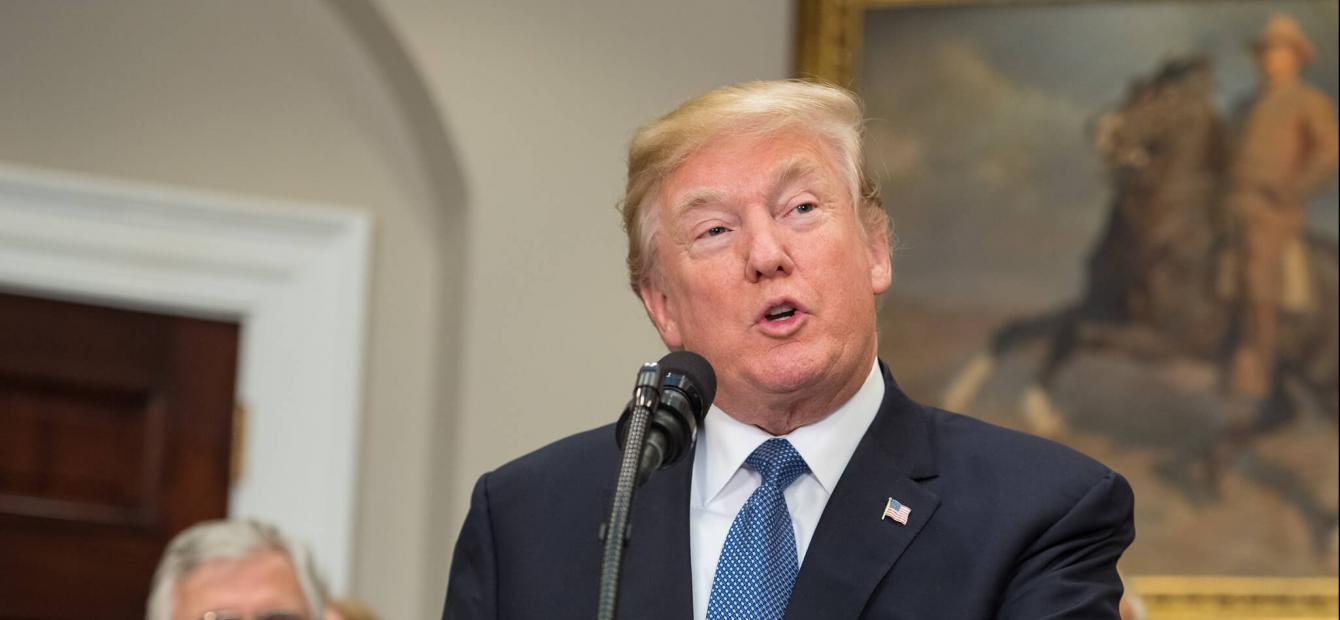
One year of ‘Making America Great Again’: Trump’s worldview
While president Trump generates almost daily turmoil and regularly changes his policy ideas, he has been remarkably consistent on a number of major foreign policy issues since the 1980s. Based on Trump’s publications, professor of American Studies Ruud Janssens shows Trump’s major ideas on the role of the United States in the world.
One year into the Trump presidency, the White House turns out be in continuous turmoil. The Russia investigations, notably the findings of Special Counsel Robert S. Mueller III, could prove an existential threat to the administration. Trump continues to be confronted by women who accuse him of sexual misconduct. The policies he suggested – from migrant banning, to ending the Affordable Health Care Act (also known as Obamacare), to his budget – are controversial, and did not get the support of the majority in Congress.
In international relations, Trump praised dictatorial leaders, and had conflicts with United States’ allies. Trump ended negotiations with Asia and Europe about free-trade pacts, terminated US’ participation in the Paris climate accords, and might have stopped peace negotiations in the Middle East with his recognition of Jerusalem as the capital of Israel. Trump’s dealings with North-Korea and Iran, concerning their nuclear capabilities, are very worrisome, and mistakenly led to a scare about a nuclear attack on Hawaii.
Trump promised to “Make America Great Again”. He never explained which situation he was referring to when the United States was apparently great or how he would reach that target specifically. The political successes of President Trump (and the Republican party, which has a majority in both the Senate and the House of Representatives) have been limited. The only two proposals that passed in Congress were the confirmation of the conservative Neil Gorsuch as Supreme Court Justice, and a new tax law.
At home: new tax law and budget proposal
The new tax law will lower taxes for businesses and higher income groups in particular. The government budget deficit will probably increase by a trillion dollars, with Republicans assuming lower taxes will lead to a growing economy to offset that deficit. The tax law also includes an effort to derail the Affordable Care Act (or Obamacare), and a permission to drill oil in the Alaska National Wildlife Refuge (a reversal of a sixty-year policy intruded by President Eisenhower).
In May, the Trump administration send a budget proposal to Congress. The budgets of most government departments would be cut, from 4% less money for the Justice and Treasury Departments, to around 30% less for the State Department and the Environmental Protection Agency. Only Veteran Affairs (6% more money), Homeland Security (7% more) and the Department of Defense (10% more) would have increased budgets. There would be less money for food and medical aid for the poorest Americans. Various government-supported institutions would be scrapped, such as National Public Radio, the United States Institute of Peace, and the National Endowments for the Arts and for the Humanities. The proposed budget of the Trump administration was not taken seriously, and declared “dead on arrival” by Republicans in Congress.1
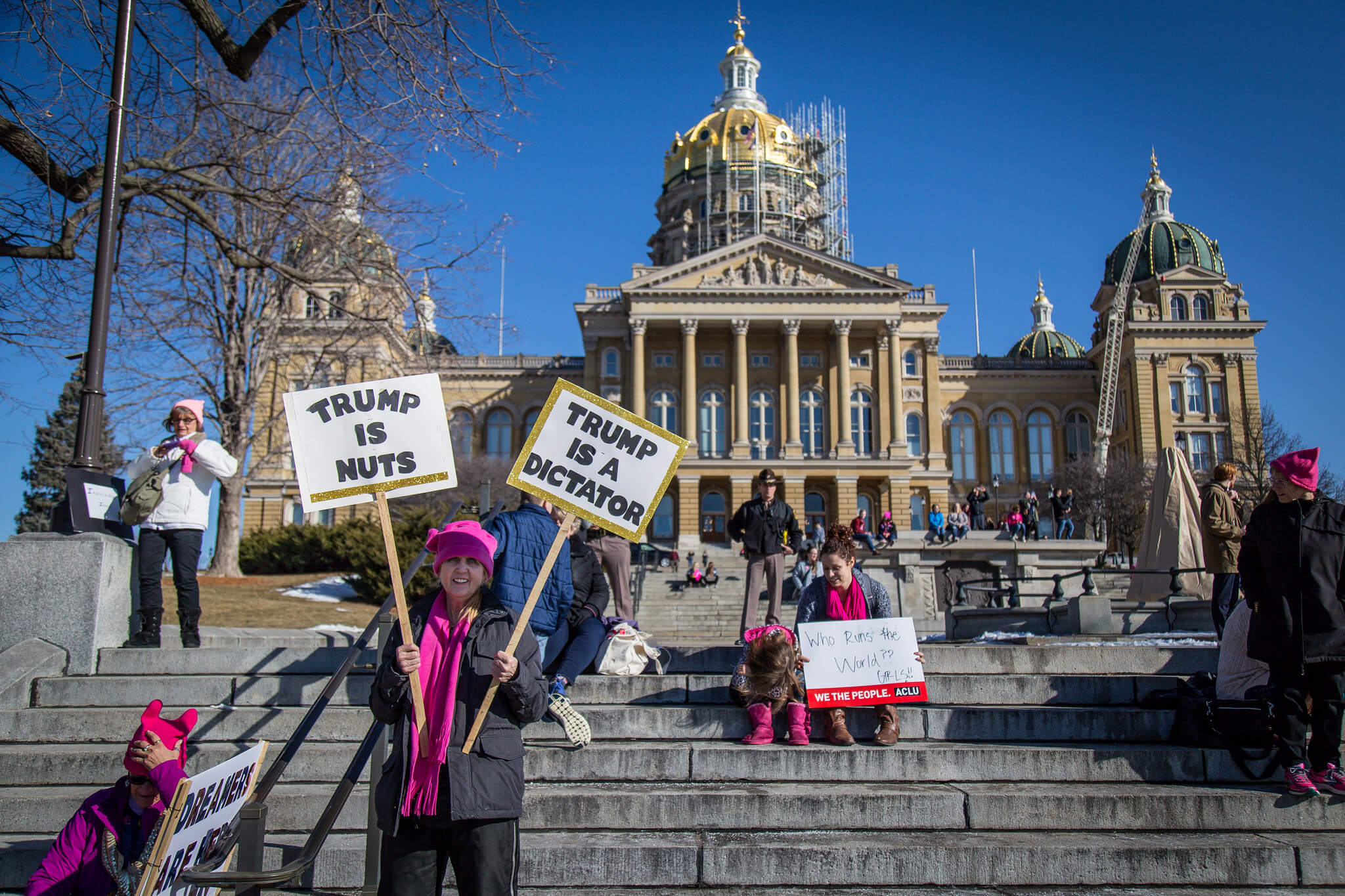
In the meantime, Congress created its own budget proposals, notably to keep the government bureaucracy financed. The fourth effort by Congress for a short-term budget compromise failed in January 2018, leading to a government shutdown. President Trump played an active role in creating this crisis. He had decided to end a temporary policy to grant a legal stay to people who had entered the US illegally as minors (Deferred Action for Childhood Arrivals or DACA). Trump challenged Congress to draw up a new policy to offer American citizenship to these people – about 800,000 – some of whom lived in the United States for decades. Congress decided to link the budget negotiations and DACA, in order to make Democrats happy about citizenship for this group of immigrants, and conservative Republicans about more defense spending. Trump refused to support two compromises co-authored by Republicans and Democrats on DACA, and consequently also doomed the federal budget.
A large number of executive orders
Up to January 9, 2018, Trump has signed 58 executive orders – substantially more than any president since Lyndon B. Johnson. Executive orders are not new legislation, but rather guidelines on how to interpret existing rules and policies. In this way Trump has reversed in particular Obama policies. Some of the executive orders made drilling by oil companies in other (former) nature reservations possible.
It is striking that the Republican President Trump with a Republican majority in both House and Senate has not been able to achieve more. With the mid-term elections coming up in November, the Republicans might lose their majority in Congress, making it even harder for Trump to pass legislation. One reaction might be, as previous presidents have done, that Trump will focus more on international relations, where Congress has a lesser role than in domestic politics, and where Trump can look presidential. I will show on the basis of Trump’s publications what his major ideas are on the role of the United States in the world. Foreign policy is a field in which Trump has been consistent on a number of major issues since the 1980s. This consistency has not always been present in other policy fields.
The role of the United States in the world
Non-Stop Spectacle
According to NBC journalist Jane C. Timm, during the election campaign Trump changed policy ideas 141 times on 23 important topics, including Muslim immigrants, ISIS, gun ownership, and abortion. As President, Trump changed his mind on such divergent topics as the prosecution of Hillary Clinton, waterboarding, the environment, and China. Some of these policy changes might be explained by opportunism, either to win the election or to succeed as president, but not all of them.
In his recent, headline grabbing book Fire and Fury: Inside the Trump White House Michael Wolff described how the political agenda in the Trump administration is an outcome of infighting by four factions in the White House: Steve Bannon and his right-wing populist agenda; Jared Kushner and Ivanka Trump and their agenda which combined Wall Street policies and family interests; Reince Priebus representing the Republican Party; and the experienced military government officials, like Secretary of Defense James Mattis, National Security Adviser H.R. McMaster, and White House Chief of Staff John Kelly, who represent traditional international power politics and a functioning bureaucracy.
It is striking that the Republican President Trump with a Republican majority in both House and Senate has not been able to achieve more
Each of these factions has attempted to get the ear of President Trump, who is depicted by Wolff as a dysfunctional leader mostly obsessed by getting respect. Wolff has been criticized for not getting all of his facts right. Journalists of The New York Times and The Washington Post have confirmed, however, that the overall image of the White House as depicted by Wolff is in line with their findings. Wolff might have listened more to Steve Bannon than to other sources, but the political infighting and lack of interest in facts and political procedures by Trump seem to be real.
The National Security Strategy
An example of this disconnect between Trump, his staff, and policy is the National Security Strategy, presented last December. The Strategy is a policy paper published by the White House in which the national goals and challenges are stated, and the means to achieve success. Although many of the major goals often remain the same from administration to administration, each new president includes statements about the policy goals he wants to achieve, often based on his election campaign. With the Trump National Security Strategy, the most obvious difference is not with the previous National Security Strategy by the Obama administration – although there are differences for sure – but between the policy aims in the strategy and the statements by President Trump.
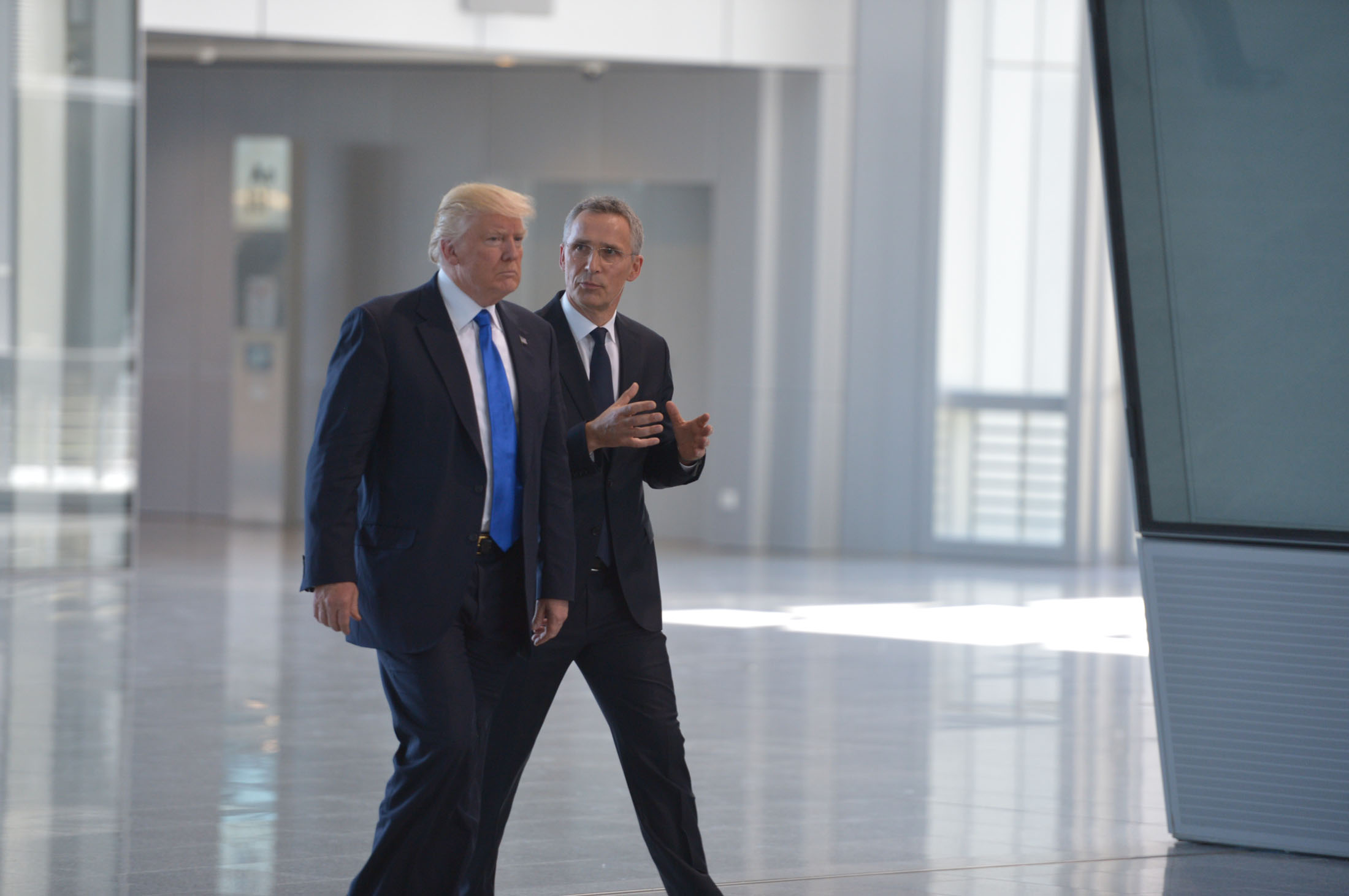
For instance, the National Security Strategy speaks of the importance of international regimes and international cooperation for a world without conflicts, while Trump sees all nations in competition and taking advantage of each other, including the traditional allies of the United States. The Strategy mentions the use of information operations by the Russian government to influence public opinion in many countries, while Trump denied any such Russian role in the American elections. In short, the National Security Strategy ought to be a document that states the main international goals of an administration, but it seems in this case to confirm the lack of agreement within the Trump administration on major issues.
Tweets and speeches
The impression of a White House in disarray is accentuated by the tweets Trump sends out and the disrespect for facts. The tweets – 2,461 in the year from his election to November 2017 – often appear to be responses to what he sees on television, or retweets of messages he finds interesting. In this way, Trump is able to dominate the news cycle. It also shows him aggressively attacking anyone criticizing him, while he simultaneously has a problem condemning white supremacists.
In tweets and in speeches, Trump accuses the media such as CNN, The New York Times, and The Washington Post of “fake” news. From inauguration day, with the size of the crowd, to the tweet “‘Muslim migrant’ beats up Dutch boy on crutches”, the White House press office has defended, in the words of Kellyanne Conway, “alternative facts.” At least the Swedish, British, and Dutch government have objected to the fabrications of Trump, notably concerning migrants in their nations.
According to a recent New York Times article, based on interviews with 60 individuals who work with the president, Trump sees himself not so much as the leader of the nation, but the presidency “as a prize he must fight to protect every waking moment”. He told aides to see “each presidential day as an episode in a television show in which he vanquishes rivals”. Those rivals are seen by Trump on television, which he watches four to eight hours a day.2
Trump’s Worldview
While Trump generates almost daily turmoil and regularly changes his policy ideas, he is consistent on a number of topics, especially in international relations. In 1987, Trump took out a one-page ad in The New York Times, The Washington Post, and the Boston Globe in which he presented his ideas how American foreign policy could be improved. Three themes, which Trump consistently has expressed since then, are introduced in the ad: the national interest is solely about the United States, and other nations – including allies – are a threat to that national interest; other nations make use of the United States; and, a deficit on the trade balance is not acceptable.3
Trump himself has raised the question why a real estate developer thinks he knows better than foreign policy experts. His explanation is simple: experts are often wrong. As he stated in The America We Deserve: “During the cold war, … [t]he best we could expect was to ‘contain’ communism, these learned people insisted. They were, of course, totally wrong – wrong about the most important international development in the last half of this century.” Trump noted in various publications this tendency to be wrong among diplomats, foreign policy experts, economists, and journalists. Not only did Trump have better ideas, he also consulted with some people to “refine” his political agenda: “I’ve read widely until I found authors who saw problems the way I do and proposed solutions that make sense.”4
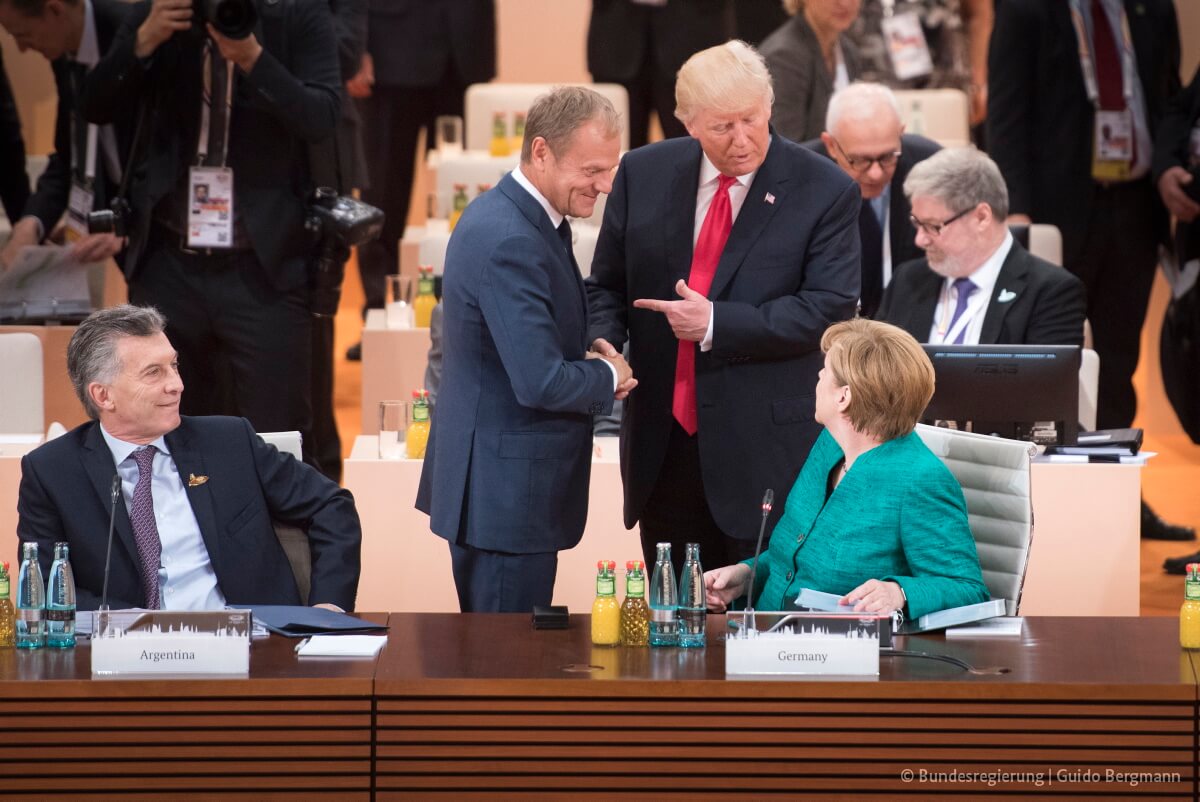
Trump is proud of his unconventional thinking, and one can wonder to which extent being unconventional became a reason to come up with controversial ideas. The recognition of Jerusalem as Israel’s capital could be seen as Trump’s urge to be unorthodox, as well as a gesture to a part of his (notably Evangelical Christian) base and campaign financier Sheldon Adelson.
Being Ripped Off
Trump is convinced that other nations make use of the United States. That can be shown, according to Trump, in the trade deficits the United States has with other countries. In The America We Deserve, Trump stated: “You only have to look at our trade deficit to see that we are being taken to the cleaners by our trading partners. … America has been ripped off by virtually every country we do business with. We need to renegotiate fair trade agreements.”5
It is unclear why Trump focuses on the trade-balance deficit. This deficit is 2.7% of GDP, which leads to the question if it is a serious problem.6 According to David Ricardo’s theory of comparative advantage, if countries specialize in products they can produce at lower costs, it will increase international trade and overall consumption.
Trump is upset about the fact that allies do not pay for American military presence in their region
Both Donald and Ivanka Trump put this idea into practice, by having their clothing lines being made in low-wage Asian counties. The advantage for American consumers is they can buy cheaper products than if they would buy only American-made goods. American agriculture wants free trade to sell their products at low costs abroad. There is a risk that the North American Free Trade Association (NAFTA) cannot be renegotiated, as Trump wants, and might lead to new import taxes between Canada, Mexico, and the United States. A possible result is that economic activities decrease, introducing broader societal consequences.
Trump is also upset about the fact allies do not pay for American military presence in their region. He noted there are American troops in Europe, Japan, South Korea, Saudi Arabia and Iraq, but that their presence was not appreciated, nor paid for. Trump complained: “We pay for the defense of France yet they vote against us at the United Nations and choose the side of the North Koreans, the Libyans, and other rogue nations.”7 In the case of Iraq his grievance was that Iraq did not pay “for their liberation” and getting “rid of Saddam Hussein and to have gained a democracy”.8 Leaving aside Trump’s disregard for the facts related to France and Iraq, he seems to have a very specific take on American military alliances. In the case of South Korea and Japan, those countries have contributed financially to the presence of American troops in their countries for many years.
In his confrontation with Angela Merkel early this year, Trump seemed to believe that NATO partners pay the United States or NATO, instead of spending their defence budgets on their own armed forces. Allegedly, Trump presented Merkel a printed out $347 billion invoice for NATO partnership.9 The important point, though, is that Trump does not seem to recognize that these military alliances are also in the American national interest, and not just a kind gesture by the United States to its allies.
Military Force
President Trump is infatuated with the armed forces. His devotion may be explained by attending New York Military Academy as his high school. Yet, he did not serve during the Vietnam War. In any case, Trump identifies with the military. As he expressed in How to Get Rich: “More and more, I see that running a business is like being a general. Calling the shots carries a great deal of responsibility, not only for yourself, but for your troops. Your employees’ lives, to a large extent, are dependent on you and your decisions. Bad strategy can end up affecting a lot of people.”10
Trump wants to use military force to intimidate other nations
Trump sees the importance of the armed forces for the global prestige of the United States. In The America We Deserve he stated: “Ultimately we have to deal with hostile nations in the only language they know: unshrinking conviction and the military power to back it up if need be. There and in that order are America’s two greatest assets in foreign affairs.”11 In Great Again he declared: “My approach to foreign policy is built on a strong foundation: Operate from strength. That means we have to maintain the strongest military in the world, by far.”12
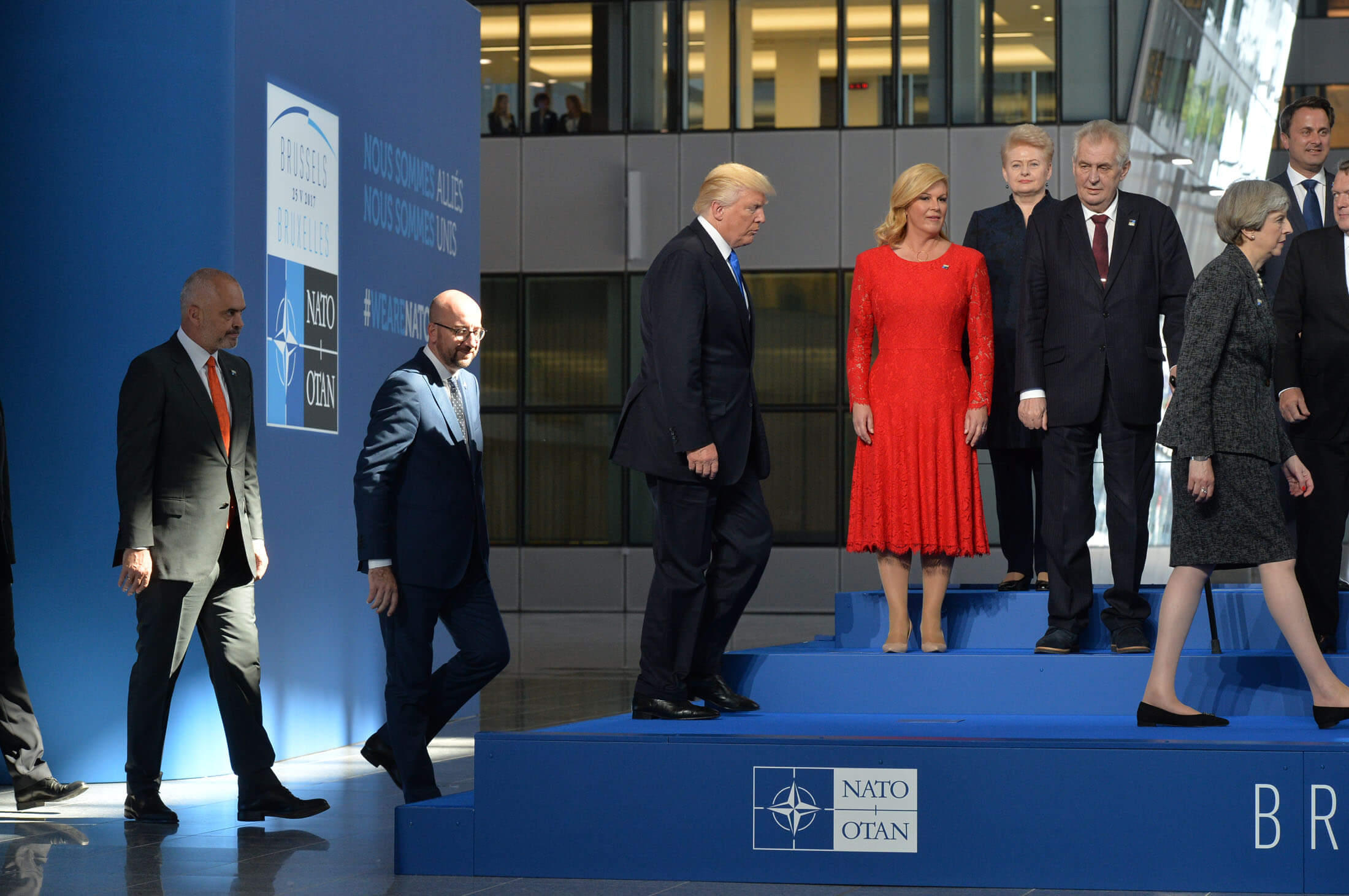
Trump wants to increase the defence budget with ten per cent. Commentators have wondered which military opponent Trump wants to defeat, and why that could not be done with the present armed forces (the US has by far the biggest defence budget globally). That is missing the point though. Trump wants to use military force to intimidate other nations. It is not so much deterrence, intimidation to prevent a war as in the Cold War, but more like gunboat diplomacy, the 19th-century approach to force other nations to give in to your wishes.
The Art of the Deal
Donald Trump defines his success, as a real estate developer and as president, in terms of making deals. In his first book, The Art of the Deal, he described his style of deal-making as “quite simple and straightforward. I aim very high, and then I just keep pushing and pushing and pushing to get what I’m after.”13 As he said in The America We Deserve: “The dealmaker is cunning, secretive, focused, and never settles for less than he wants.”14
Controversy, conflicts, and criticism (by losers) are part of Trump’s take on the world
Trump’s idea of deal-making seems to be based on perceptions of (one’s own) strength, and how the weakness of the other party needs to be exploited to one’s advantage. As he expressed in Great Again: “The side that needs the deal the most is the one that should walk away with the least.”15 This idea comes close to the concept of a zero-sum game, in which a nation either wins or loses in international relations. In such a worldview, the notion of reaching compromises does not exist, and trying to get to a “win-win” scenario in negotiations is anathema. This conviction might also explain Trump’s dislike of diplomats.
Where Do We Stand After One Year?
Trump revels in all these controversies. He is worried, for sure, that he does not get the respect he believes he deserves as a president. Yet, critics of his actions give him the opportunity to strengthen his ties with his political base, by being more contentious. Trump has created a worldview in which he is a leader, one who makes deals. Others either try to make use of the United States or are unhappy about getting a worse deal because they are not as powerful as the United States. Controversy, conflicts, and criticism (by losers) are part of his take on the world.
Yet, when or how America would be great again, his campaign promise, is less clear. The question is rather to which extent Trump is undermining American “greatness”. American leadership on environmental issues, free-trade pacts, peaceful negotiations with emerging nuclear powers like North Korea and Iran, and military alliances (in Europe and Asia) is waning or has disappeared. China’s role in international diplomacy has increased. Europe and Asian powers are now negotiating trade deals without Washington. Domestically, many Americans with lower incomes will have a hard time, with the assault on Obamacare, and the expected efforts to dismantle social care next year, to pay for the new tax plan. Harder to measure are the consequences of Trump’s actions and attitude for the trust citizens have in democracy, both in the United States and internationally.
- 1 Lauren Gambino, ‘Republicans voice opposition to Trump’s budget: “Dead on arrival” ’, The Guardian, May 23, 2017.
- 2 Maggie Haberman, Glenn Thrush & Peter Baker, ‘Inside Trump’s hour-by-hour battle for self-preservation’, The New York Times, December 9, 2017.
- 3 Michael Oreskes, ‘Trump Gives a Vague Hint of Candidacy’, The New York Times, September 2, 1987.
- 4 Donald Trump with Dave Shiflett, The America We Deserve (Los Angeles: Renaissance Books, 2000), kindle edition, location 1281 and 290.
- 5 Donald Trump with Dave Shiflett, The America We Deserve (Los Angeles: Renaissance Books, 2000), kindle edition, location 1690.
- 6 James McBride, ‘The U.S. Trade Deficit: How Much Does It Matter?’, Council on Foreign Relations, October 17, 2017.
- 7 Donald Trump with Dave Shiflett, The America We Deserve (Los Angeles: Renaissance Books, 2000), kindle edition, location 1660.
- 8 Donald J. Trump, Time to Get Tough: Making America #1 Again (Washington, DC: Regnery Publishing, Inc., 2011), kindle edition, location 1661.
- 9 Daniel Politi, ‘Trump Reportedly Handed Merkel a $374 Billion Invoice for NATO’, Slate, March 26, 2017.
- 10 Donald Trump with Meredith McIver, How to Get Rich (New York: Ballantine Books, 2004), 3.
- 11 Donald Trump with Dave Shiflett, The America We Deserve (Los Angeles: Renaissance Books, 2000), kindle edition, location 1551.
- 12 Donald J. Trump, Great Again: How to Fix Our Crippled America (New York: Threshold Editions, 2015; reprint of Crippled America), kindle edition, location 478.
- 13 Donald Trump, The Art of the Deal, Random House, November 1987, p. 45.
- 14 Donald Trump with Dave Shiflett, The America We Deserve (Los Angeles: Renaissance Books, 2000), kindle edition, location 1261.
- 15 Donald J. Trump, Great Again: How to Fix Our Crippled America (New York: Threshold Editions, 2015; reprint of Crippled America), kindle edition, location 572.





0 Reacties
Reactie toevoegen